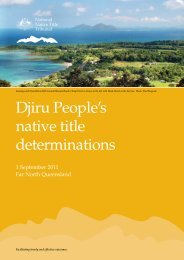Biodiveristy_State of Environment report - Mission Beach Cassowaries
Biodiveristy_State of Environment report - Mission Beach Cassowaries
Biodiveristy_State of Environment report - Mission Beach Cassowaries
- No tags were found...
Create successful ePaper yourself
Turn your PDF publications into a flip-book with our unique Google optimized e-Paper software.
4. Deficiencies in DataAs noted in the sections dealing with fauna and flora, thereis little reliable information for most species present in theShire. A record <strong>of</strong> the total diversity <strong>of</strong> species is not yetcomplete, and there is no real information on thedistribution <strong>of</strong> species.This should be improved, but given the number <strong>of</strong> speciesin the Shire priority should be for the endangered species,and towards identifying species that may have locallylimited distributions. This will assist in further conservationefforts.Rec: QPWS work towards recording the diversity <strong>of</strong> speciesin the Shire - QPWSRec: QPWS compile data and mapping <strong>of</strong> the distribution <strong>of</strong>conservation significant species in the Shire - QPWSRec: Engage university students and other tertiaryinstitutions to conduct research projects on ecosystems,flora and fauna in the Shire - QPWS, Council, TAFERec: Lobby Earthwatch to establish research projects in theShire - Council5. ReferencesAIMS Website (2005a) "Interactive data summaries for the Great BarrierReef" Australian Institute Marine Science, Viewed on 15/1/5, http://www.aims.gov.au/monmap/monmap.htmAIMS Website (2005b) "A mangrove is more than just a tree ..."Australian Institute <strong>of</strong> Marine Science, Viewed on 22/8/5, http://www.aims.gov.au/pages/research/project-net/mangroves-01/apnetmangroves01.htmlAllanson S. (2005) Queensland Parks and Wildlife Service, <strong>Mission</strong><strong>Beach</strong> - Personal Communication, May 2005.ANZECC (2000) "National Water Quality Management Strategy -Australian Guidelines for Water Quality Monitoring and Reporting"Australian and New Zealand <strong>Environment</strong> and Conservation Council/Agriculture and Resource Management Council <strong>of</strong> Australia and NewZealand, October 2000Australian Greenhouse Office (2004) "Climate change in the Cairns &Great Barrier Reef Region: Scope and Focus for an IntegratedAssessment" Australian Greenhouse Office, Commonwealth <strong>of</strong>Australia. Viewed on 222/8/5, http://www.greenhouse.gov.au/impacts/publications/pubs/gbr.pdfBell, R. (1996) "Johnstone River Catchment Revegetation Strategy"Johnstone River Catchment Management Association, QueenslandBentrupperbaumer J. (1992) "Cassowary monitoring program for thewhole <strong>of</strong> Cardwell and part <strong>of</strong> Johnstone Shires, North Queensland."Unpublished <strong>report</strong> to Queensland National Parks and WildlifeService Grant Scheme for research on Rare and Threatened Species,Wildlife Preservation Society, Tully.Biodiversity Strategy (2003) "Strategy for the Conservation <strong>of</strong>Biodiversity in the Johnstone Shire" Dryden, B., Johnstone ShireCouncil, InnisfailC4 (2005) Community for Cassowary and Coastal Conservation Inc,<strong>Mission</strong> <strong>Beach</strong>CSIRO Website (2005)"CSIRO cane toad research" CommonwealthScientific and Industrial Research Organisation, Australia. Viewed on22/8/5, http://www.csiro.au/index.asp?type=faq&id=CaneToadControlDEH (2004) "Draft Sustainable and legal Indigenous harvest <strong>of</strong> MarineTurtles and Dugongs in Australia - A national approach". MACCTaskforce on Dugong and Marine Turtle Populations, Department <strong>of</strong>the <strong>Environment</strong> and Heritage, Commonwealth <strong>of</strong> Australia. Viewedon 22/8/5, http://www.deh.gov.au/coasts/species/turtles/pubs/nationalapproach.pdfDEH Website (1999) "Hill acts to protect marine turtles" Department <strong>of</strong><strong>Environment</strong> and Heritage, Commonwealth <strong>of</strong> Australia. Viewed on22/8/5, http://www.deh.gov.au/minister/env/99/mr12aug99.htmlDEH Website (2005)"Threat Abatement Plan for Predation, HabitatDegradation, Competition and Disease Transmission by Feral Pigs"Department <strong>of</strong> Environement and Heritage, Commonwealth <strong>of</strong>Australia. Viewed on 12/9/2005, http://www.deh.gov.au/biodiversity/threatened/publications/tap/pig/DPI&F (2005) "Fisheries Long Term Monitoring Program" Requesteddata reproduced with permission <strong>of</strong> Queensland Department <strong>of</strong>Primary Industries and Fisheries, Copyright <strong>State</strong> <strong>of</strong> Queensland,2005DPI&F Website (2005a) "Tilapia" Queensland Department <strong>of</strong> PrimaryIndustries: Brisbane, Viewed on 22/8/5, http://www.dpi.qld.gov.au/fishweb/1406.htmlDPI&F Website (2005b) " Coastal Habitat Resources Information System(CHRIS)" Viewed on 18/8/2005, http://chrisweb.dpi.qld.gov.auDuke N.C., Bell A.M., Pederson D.K. Roelfsema C.M., Godson L.M.Zahmel K.N., Mackenzie J. Bengtson-Nash S. (2003) "MackayMangrove Dieback Investigations in 2002 with Recommendations forFurther Research, Monitoring and Management - Report to theQueensland Department <strong>of</strong> Primary Industries, Northern FisheriesCentre and the Community <strong>of</strong> Mackay Region" Marine BotanyGroup, Centre for Marine studies. University <strong>of</strong> QueenslandEPA (2005a) "Regional Ecosystem Database Information" QueenslandHerbarium, <strong>Environment</strong>al Protection Agency, QueenslandEPA (2005b) "<strong>Environment</strong>al Protection Agency (2005) WildNetDatabase" <strong>Environment</strong>al Protection Agency, Queensland, 15February 2005EPA Website (2005) "Wet tropics forest transfer" <strong>Environment</strong>alProtection Agency, Queensland. Viewed on 22/8/5, http://www.epa.qld.gov.au/parks_and_forests/management/forest_transfer_processes_in_queensland/wet_tropics_forest_transfer/GBRMPA Website (1998) “<strong>State</strong> <strong>of</strong> the Great barrier reef World HeritageArea - Seagrass” Available @ http://www.gbrmpa.gov.au/corp_site/info_services/publications/sotr/1998/seagrass_frame.html)GBRMPA Website (2005a) "Frequently Asked Questions " Viewed on22/8/5, http://www.gbrmpa.gov.au/corp_site/key_issues/conservation/world_heritage_faq.html#When%20and%20why%20was%20the%20GBRWHA%20listed%20as%20a%20World%20Heritage%20PropertyGRMPBA Website (2005b) "<strong>State</strong> <strong>of</strong> the Great barrier Reef MarineHeritage Area Report 1998 - Marine Reptiles" Great Barrier ReefMarine Park Authority. Viewed on 22/8/5, http://www.gbrmpa.gov.au/corp_site/info_services/publications/sotr/1998/reptiles_frame.htmlGoosem, S., Morgan, G. & Kemp, J.E., (1999) "Conservation Status <strong>of</strong>Queensland’s Bioregional Ecosystems – Wet Tropics" <strong>Environment</strong>alProtection Agency, QueenslandHardin, G. (1968) "The Tragedy <strong>of</strong> the Commons," Science, 162(1968):1243-1248.Haynes, D., Ralph, P., Müller, J., Prange, J., Michalek-Wagner, K. andWaterhouse, J. (2000) "The Occurrence and Impact <strong>of</strong> Herbicides inthe Great Barrier Reef, Australia” Reef Research Volume 10 No 2-4June – December 2000, Great Barrier Reef Marine Park AuthorityHervey, B. (2003) C4, Community for Cassowary and CoastalConservation Inc - Personal Communication, May 2003Hyde, M. (2002) "Johnstone Shire Pest Management Plan 2002 –2006",Johnstone Shire Council, Queensland.Jebreen, E.J., Helmke S.A., Bullock C.L. & Hutchinson M.J. (2002)"Fisheries Long-Term Monitoring Program: Freshwater Report: 2000-2001". Department <strong>of</strong> Primary Industries, Queensland. DPI QI02058JES (2005) Johnstone Ecological Society - Personal Communication, June2005.McKenna, S., Rasheed, M. and Thomas, R. (DPI&F 2005) "Long-TermSeagrass Monitoring in the Port <strong>of</strong> Mourilyan" Marine EcologyGroup Northern Fisheries Centre Department <strong>of</strong> Primary IndustriesInformation Serries QI05037 November 2004Moore L.A. and Moore N.J. (1998) 'Cassowary Conservation Roads - ACassowary management Strategy and Road Upgrade Assessment forEl Arish and Tully-<strong>Mission</strong> <strong>Beach</strong> roads, <strong>Mission</strong> <strong>Beach</strong>. Reportconducted for the Department <strong>of</strong> Main Roads, December 1998.Natural Resource Management Board Inc. (2000) "Wet Tropics regionalStrategy – Natural Resource Management" Natural ResourceManagement Board (Wet Tropics) Inc., QueenslandNew Scientist Website (2003) "Copper decimates coral spawning" EmmaYoung in New Scientist, 18 November 2003. Viewed on 22/8/5,http://www.newscientist.com/article.ns?id=dn4391New Scientist Website (2004a) "Sewage nutrients fuel coral disease"Rachel Nowak in New Scientist, 11 January 2004. Viewed on 22/8/5,67



